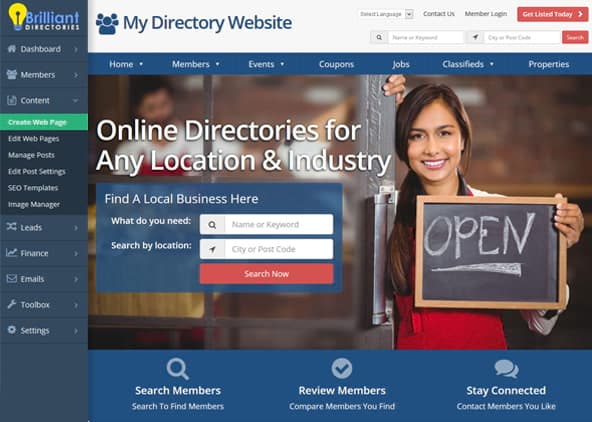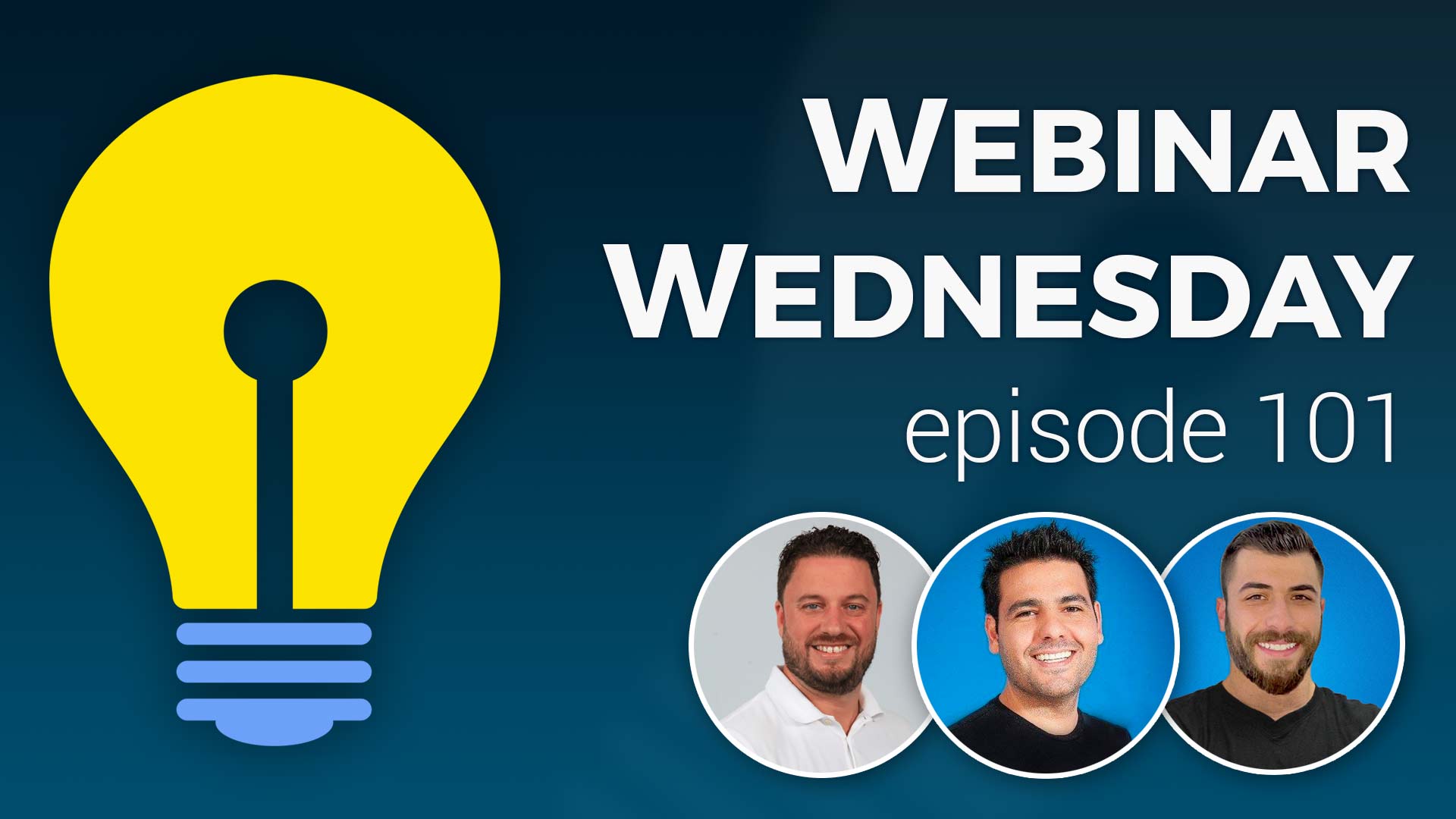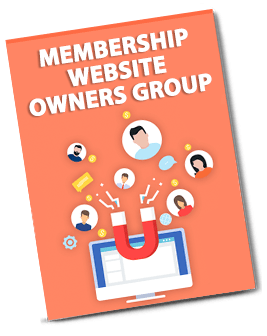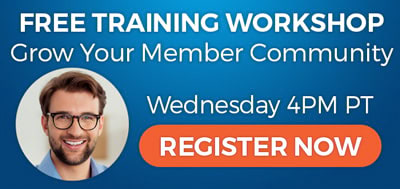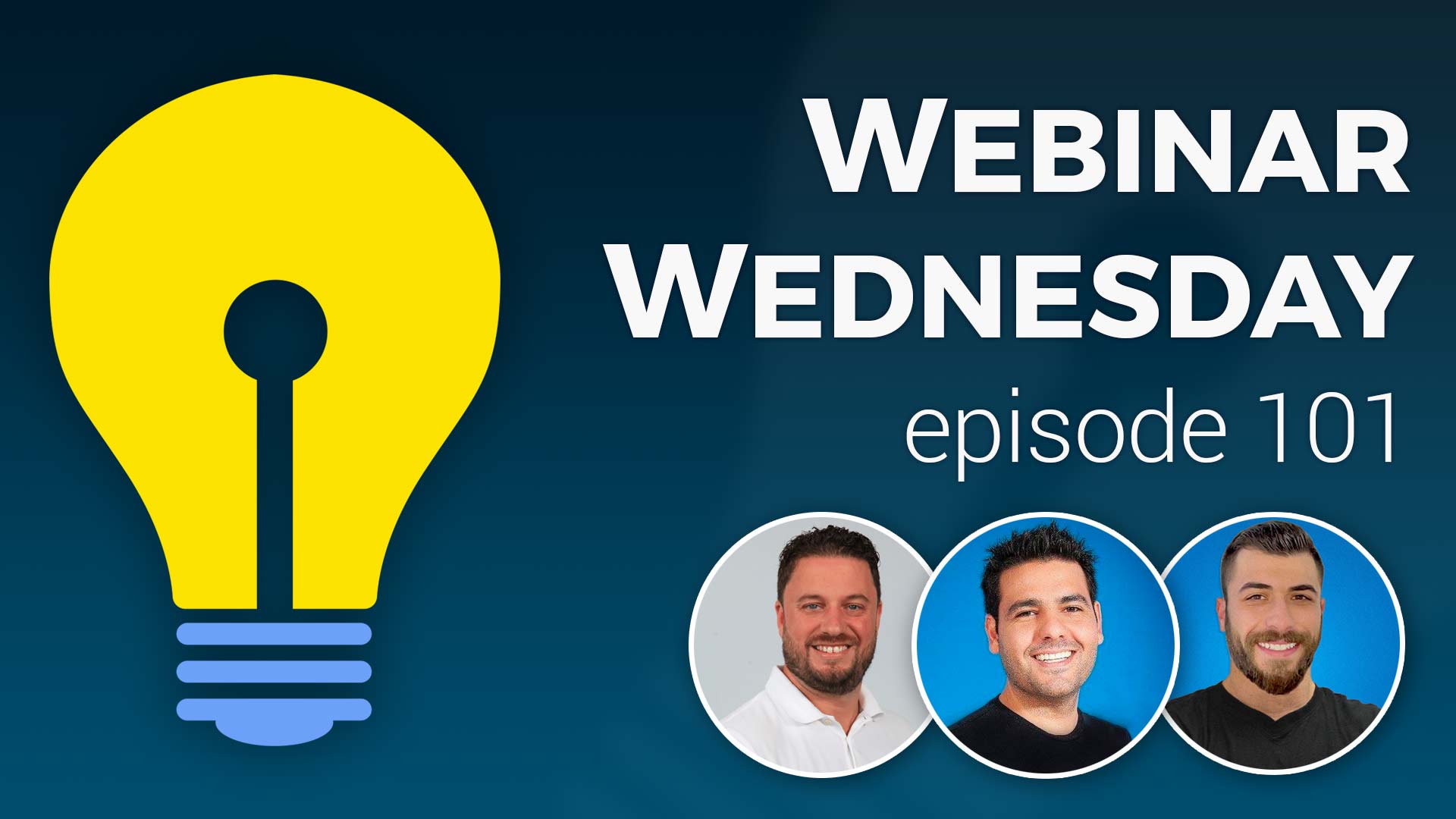
Key Topics:
- 2:33 – 2 New Add-Ons
- 2:57 – New Add-On: Reviews with Photos
- 6:02 – New Add-On: Community Comments
- 10:20 – Update: Express Member Registration
- 13:31 – Update: Select “Smart Lists for Newsletters
- 16:34 – Update: Hide Parent Account from Search Results – Multi-Member Manager add-on
- 17:56 – Update: Homepage Streaming Settings – Now in Pop-Ups
- 19:11 – Update: Title Settings for Streaming Sections
- 20:59 – Coming Soon: Exclude Lists when Sending Newsletters
- 21:09 – Coming Soon: Main Menu for Logged In Members
- 21:44 – Coming Soon: Force-End Your Staff Admin Sessions
- 22:05 – Coming Soon: “Email Settings” for Any Form Submission
- 22:58 – Coming Soon: Parent Accounts can Toggle Back from Sub-Accounts
- 23:37 – Thank you for 100+ Webinar Wednesdays
- 24:14 – Tip of the Week: Define Your Offering to Attract More Members by Patrick Brunelle
- 25:53 – Let’s Meet Patrick Brunelle
- 26:38 – 1) Identifying Solutions Your Members Need
- 35:21 – 2) Choose/Emulate A Proven Strategy
- 40:08 – 3) Create Content That Converts
- 46:31 – 4) Get Early Feedback – More Info
- 54:18 – Special Gift from Patrick – More Info
- 57:01 – Presentation Recap
- 59:56 – How to charge users to claim their listing?
- 1:03:38 – How to create specific admin roles for your staff?
- 1:09:17 – How to create a page with a hero section/banner to showcase members within a specific membership plan?
- 1:16:28 – For a new membership site, is it best to offer members a free trial first and upsell them later?
- 1:20:32 – How much should you charge your members? – More Info

 AI-Generated Transcript – Please excuse any inaccuracies
AI-Generated Transcript – Please excuse any inaccuracies
2 New Add-Ons (00:02:33)
- Two new add-ons have officially arrived and are now available for VIP Add-ons Club members, with these add-ons being particularly significant, especially the community comments one (00:02:34).
- The two new add-ons are already available in the admin area for VIP Add-ons Club members, allowing them to access and utilize these new features (00:02:45).
- The add-ons have been reviewed in previous webinars, but a quick demonstration will be provided to show where to enable these on the site and how they function (00:02:51).
New Add-On: Reviews with Photos (00:02:57)
- The reviews with photos feature allows visitors to leave testimonials or reviews about their experience with members, and also include photos with their reviews, which is particularly great for visually oriented businesses such as restaurants, home services, designers, or architects (00:02:57).
- To enable the feature, users need to go to their membership plans, select which membership levels can have images left with reviews, and set “allow image uploads with reviews” to yes under the member review settings (00:03:32).
- The feature has two caveats: first, only subscribers or members of the site who are already logged in can upload images with their reviews, and second, the feature is mainly for security and to prevent spam and nefarious activity (00:04:07).
- If a user is logged in and the feature is enabled for the member they are leaving a review for, they will be prompted to add images with the review, and the system will upload the images with the reviews (00:04:44).
- The uploaded images will be displayed with the reviews on the member’s profile page, and users can click on the images to view them in a larger format (00:05:35).
- In a future phase, all reviews with images will be displayed in a gallery, allowing users to view all the photos for all reviews (00:05:51).
New Add-On: Community Comments (00:06:02)
- The community comments add-on allows members to leave comments underneath posts, such as blog articles, eliminating the need for third-party commenting tools, and can be enabled under the content section in the dashboard (00:06:02).
- To enable community comments, users need to go to the comment settings area and switch the enable post comments option to yes, and can also choose the title text to be displayed above the comments section (00:06:39).
- The comment settings area also allows users to show the comment count on the post page, moderate comments, and select which membership plans require comment moderation (00:07:08).
- Users can enable or disable community comments for different post types, such as jobs, blog articles, property listings, and products, and can also set a maximum character limit for individual comments to minimize spam (00:07:48).
- Once community comments are enabled, members can leave comments on published posts, and other members can reply to those comments, with all comments being manageable in the post comments page in the admin area (00:08:34).
- The post comments page is similar to the member reviews page and allows users to manage all comments, including those with images added to member reviews (00:09:47).
Update: Express Member Registration (00:10:20)
- The Express Member Registration update allows users to sign up for a free membership plan directly from the login page, and it is recommended to enable this feature on the site (00:10:20).
- With this update, one of the free membership plans can be assigned to the Express Member Registration, and users can register for it without being redirected to the checkout page (00:10:44).
- To set up the Express Member Registration, go to the general settings, select the Express Sign Up Membership Plan, and choose a free membership plan from the available options (00:11:00).
- The Express Member Registration feature adds a new tab to the login page, allowing users to toggle between login and registration, and it also allows users to register for a new account without verifying their email address (00:11:36).
- This feature can increase user and member registrations for free subscribers, as it provides a convenient way for users to register for an account when prompted to log in, such as when leaving a comment or bookmarking a post (00:13:05).
- The Express Member Registration feature is available in various areas of the Berlin Directories platform, including the coupons page, where users can register for an account without leaving the page (00:12:28).
Update: Select “Smart Lists for Newsletters (00:13:31)
- The ability to select smart lists for newsletters is now available, allowing users to create a group of members into a smart list from the search members page in the admin (00:13:31).
- A smart list can be created by searching for specific members, such as those located in California with claimable listings, and saving the results as a dynamic list that automatically updates when new members meet the defined criteria (00:13:34).
- The smart lists can be found under the emails tab, and users can now schedule a newsletter campaign and choose to include or exclude specific smart lists, allowing for more targeted and granular email blasts (00:14:29).
- The smart list feature is dynamic, meaning that if a new member joins and meets the defined criteria, they will be automatically added to the list, and users can choose to send hyper-focused email newsletters to specific groups (00:14:55).
- Future updates to the newsletter feature will include the ability to choose lists to include and exclude, as well as more reporting and statistics tools to segment lists and get more information about email newsletters (00:15:48).
- The ability to choose smart lists for email campaigns is now available for all users, and upcoming updates will focus on improving the newsletter feature with more TLC, reporting, and statistics (00:16:29).
Update: Hide Parent Account from Search Results (00:16:34)
- The multi-member manager add-on allows a parent account to create additional sub-accounts underneath it, but until now, the parent account would display in the search results (00:16:34).
- The parent account is sometimes just a manager account, and the sub-accounts are the ones that should be visible in the search results, so an option to hide the parent account has been added (00:16:47).
- To activate this option, users with the multi-member manager add-on can go to membership plans, edit a membership plan, and under post publishing, activate sub-accounts and select the option to hide the parent account (00:17:00).
- This new feature will prevent the parent account from displaying in the directory’s search results, and only the sub-accounts will be visible (00:17:26).
- This update was a result of a recommendation made in previous Webinar Wednesdays, and the multi-member manager add-on allows a single member to create additional sub-accounts underneath them (00:17:32).
Update: Homepage Streaming Settings – Now in Pop-Ups (00:17:56)
- The homepage streaming settings in the design settings area have been updated to be in pop-ups, allowing for easier access to specific settings for streaming sections (00:17:56).
- The settings for all streaming sections, including homepage divider settings and about website and join offer settings, are now located in blue button pop-ups under the home page layout section (00:18:00).
- When choosing to stream something on the home page, such as top categories or events, the individual settings for those sections can be found in the corresponding blue button pop-ups (00:18:37).
- The update has caused some confusion, with some users wondering where the homepage divider settings had been moved to, but they can now be found in the pop-ups (00:18:56).
- The new pop-up system allows for more organized and streamlined editing of streaming section settings, with each section’s settings contained within its own pop-up (00:18:45).
Update: Title Settings for Streaming Sections (00:19:11)
- The title settings for streaming sections can now be adjusted to create a strong design aesthetic for the home page, allowing for changes to font styling, including title alignment, font size, and font weight (00:19:11).
- To access these settings, users can go to the design settings and scroll down to the home page search settings, where they will find the last five options, including title alignment, title font weight, and title font size (00:19:31).
- Previously, the title sections above the streaming options had no settings and were always aligned left with a font size of 30 pixels, but now users can increase the font size, make it bold or skinny, and center it to match the aesthetic of their site (00:20:11).
- Updating the title settings can make the streaming sections look better and bring more attention to them, with options to customize the title alignment, font size, and font weight to suit the site’s design (00:20:35).
- The title settings are located in the design settings, under home page layout, and users are recommended to check them out and edit them if they are using streaming sections on their home page (00:20:45).
Coming Soon: Exclude Lists when Sending Newsletters (00:20:59)
- The ability to exclude lists when sending newsletters is a feature that will be available soon, allowing for more granular control (00:21:03).
- This feature is considered a huge improvement and will help users achieve more targeted results when sending newsletters (00:21:08).
- The upcoming feature to exclude lists is part of a list of new additions, and its implementation is anticipated to enhance the overall user experience (00:21:00).
Coming Soon: Main Menu for Logged In Members (00:21:09)
- A survey was taken in the Facebook group to gather feedback on the main menu, and it was suggested that a different main menu could be shown when members are logged in to the site (00:21:10).
- The ability to clone the main menu and create an alternate main menu for logged-in members will be available, allowing for a unique portal experience with a public-facing main menu and a separate main menu for logged-in members (00:21:18).
- This feature is expected to be highly valuable, and it will also be applied to the mini nav at the top of the page, giving users the option to have one or the other (00:21:37).
Coming Soon: Force-End Your Staff Admin Sessions (00:21:44)
- The ability to force-end any staff admins logged into the backend dashboard is going through its final QA, allowing administrators to terminate all active sessions (00:21:44).
- This feature is particularly useful in situations where the system may have been compromised, enabling administrators to quickly respond and secure their system (00:21:49).
- With this feature, administrators will be able to force-end all sessions on any device worldwide with a single button, and then reset the password for additional security measures (00:21:56).
- The force-end sessions feature provides an extra layer of security, allowing administrators to take immediate action in case of a potential security breach, and then take further steps to secure their system by resetting the password (00:22:01).
Coming Soon: “Email Settings” for Any Form Submission (00:22:05)
- The ability to have email settings for any form submitted is a new feature, allowing users to select an email that goes to the visitor or admin after a form is submitted, such as a newsletter or contact us form (00:22:05).
- Currently, email settings are only supported for the newsletter and contact us forms, as well as custom forms created by users, but this new feature will expand to other forms (00:22:24).
- Many users have requested to receive notifications when someone posts a coupon, creates an article, or fills out their member listing, which are all forms that users fill out (00:22:31).
- With the new email settings feature, users will be able to set up notifications for any form submission, allowing them or their staff to receive email responses when a form is completed or submitted (00:22:48).
- This new feature will enable users to get notified when any form is filled out on their site, providing more flexibility and control over email notifications (00:22:54).
Coming Soon: Parent Accounts can Toggle Back from Sub-Accounts (00:22:58)
- A new feature is being developed to allow parent accounts to toggle back from sub-accounts, which is related to the multi-member manager, and this will enable parent accounts to log in and manage sub-accounts more easily (00:22:59).
- Currently, there is a roadblock that prevents getting back to the parent account, but the new feature will create a secure way for parent accounts to toggle freely between their sub-accounts and back to the master parent account (00:23:02).
- The new feature will provide a convenient way for parent accounts to switch between their sub-accounts and the master parent account, and some related updates, such as the same page express member sign up, have already been pushed (00:23:22).
- The updates are part of the BD Lab updates, and all updates are now caught up, with some features already implemented, such as the same page express member sign up, which was at the top of the list (00:23:26).
Thank you for 100+ Webinar Wednesdays (00:23:37)
- The last webinar was Webinar 101, and the community showed appreciation for the event (00:23:39).
- The community has surpassed 100 webinars over the last two and a half years, and the webinars will continue due to the positive feedback and participation from the community (00:23:46).
- The community’s feedback, including suggestions, is greatly valued and appreciated, and a special thank you is extended to the entire community for being part of the webinars and participating (00:23:55).
- The next 100 webinars are anticipated, and the community’s participation is looked forward to (00:24:03).
- A special guest is joining the event, and the discussion will proceed to the next topic (00:24:08).
Tip of the Week: “Define Your Offering to Attract More Members” by Patrick Brunelle (00:24:14)
- Patrick Brunelle from Project is a guest in the webinar, and he has a history of working with the Brilliant Directories team, where he achieved amazing things for the community, (00:24:14).
- Patrick was part of the webinar back in 2017 and has been invited again to share his expertise on defining an offering and attracting more members, (00:24:37).
- The topic of discussion is how to define an offering and brand story, with Patrick providing actionable steps that can be taken to adjust things on a website and change the trajectory of a project, (00:25:30).
- Patrick’s presentation aims to help the community by sharing important information on defining an offering, with the goal of attracting more members, (00:25:32).
- The discussion is focused on providing valuable insights and tips that can be applied immediately, with Patrick taking the lead in sharing his knowledge and experience, (00:25:48).
Let’s Meet Patrick Brunelle (00:25:53)
- Patrick Brunelle works with startups, often getting involved at the beginning of their journey, and has been fortunate to work with amazing people and projects, learning new things along the way (00:25:53).
- Over the years, Patrick has learned valuable lessons from working on various projects and with clients, and he intends to share some of these lessons to help make a difference (00:26:18).
- Patrick’s experience includes doing basic core setups and developing strategies that have evolved over time, which he hopes to share as good insights with everyone on the call (00:26:24).
1) Identifying Solutions Your Members Need (00:26:38)
- Defining an offering involves identifying a product that members want to pay for to solve a problem, and this requires figuring out who the target personas are, including their age, websites they visit, products they buy, and problems they encounter (00:26:38).
- To identify the target personas, it is necessary to write down a detailed description of who they are, what kind of problems they are encountering, and how the product can help them solve those problems (00:26:42).
- The goal of identifying the target personas is to come up with an idea or solution to a problem that they would be willing to engage with, and this can be achieved through a brainstorming process, ideally with one or two people to bounce ideas off of (00:27:00).
- Once an idea is thought to have been identified, it can be bounced off two or three people who are similar to the potential customer to gauge their interest before going too far into the project (00:28:05).
- The original idea for a project is often not the final piece of the equation, and it is common for the final phase of a directory project to be a full-fledged directory where one group connects with another (00:28:30).
- Launching a full-fledged directory may not be the best initial approach, and a simpler solution can be more effective for entering a market, such as creating a simple product and website to build memberships (00:29:03).
- A concrete example of an effective strategy for launching a new directory is to start with a simple product and website, and get users to create memberships, which can then be built upon to add more value (00:30:08).
- The key to a successful directory project is to identify a problem that the target personas are willing to pay to solve, and to create a solution that meets their needs, which can be achieved through a process of brainstorming, testing, and iteration (00:30:21).
- To launch a successful directory, it’s essential to identify a solution to a problem and focus on building momentum, especially for startups, by offering something valuable in exchange for an email address, such as a webinar or a checklist with tips, and then nurturing relationships with potential clients (00:30:36).
- The key to launching a directory is to start with a simple model, such as solving an actual problem, rather than trying to launch a full-fledged directory, which can lead to the chicken or the egg problem of whether to get the service providers or the people looking for them first (00:31:27).
- To get in touch with the target demographic, it’s recommended to lean on personal networks, such as friends, family, or acquaintances who are similar to the persona, and ask for their time to discuss the project and gather feedback (00:33:02).
- Another way to connect with the target demographic is through social media groups, where you can leave a comment and ask to speak with someone who fits the persona, and then have a conversation to extract the problem from them or discuss a potential solution (00:33:16).
- When speaking with the target demographic, the goal is to either validate an existing idea or extract the problem from them, and this can be done by asking questions and gathering feedback to determine what they need and how the directory can provide value (00:33:41).
- To find out where the target demographic is online and get them to take a survey, it’s recommended to use personal relationships, social media groups, and other online platforms to connect with them and ask for their input, and to ask questions that are relevant to the directory and the problem it’s trying to solve (00:32:09).
- When launching a directory, it’s common to have some personal relationships or familiarity with the industry, which can be leveraged to get started, and it’s also possible to cold call businesses, but it’s more difficult and less effective than using personal networks (00:32:27).
- The goal of the initial conversation with the target demographic is to determine what they need and how the directory can provide value, and to gather feedback and input to validate the idea and make improvements (00:33:57).
- To gather information and understand the needs of potential customers, questions are asked, such as what the person likes most about being a member of other websites, what they like least, and if they are having trouble getting customers, in order to extract useful information and figure out solutions (00:34:02).
- The information gathered from asking questions can be used to create assets like webinars, articles, and downloadable guides that are fairly simple to create and can help solve problems for potential customers (00:34:30).
- The process of starting a project involves a discovery phase where entrepreneurs try to identify areas where they can create something new and useful, and this process can be driven by the entrepreneur’s knowledge and experience within an industry (00:34:51).
- The discovery phase is an important part of the process, as it allows entrepreneurs to explore different ideas and identify opportunities to create something new and valuable, even if they don’t have a specific idea in mind at the start (00:35:04).
- Creating a new product or service can seem like a lot of work, but it can also be a rewarding experience for entrepreneurs who are willing to put in the effort to understand the needs of their customers and create something that meets those needs (00:35:15).
2) Choose/Emulate A Proven Strategy (00:35:21)
- To get an idea for a directory without having to invent it, there is an incredible amount of success that has already been created, and by analyzing what catches your eye, such as an ad on Facebook or a webinar, you can identify what was offered and how it was presented to gain interest (00:35:22).
- By taking a step back and analyzing what was offered and how it was presented, you can see what can be emulated from successful companies, maybe not exact competitors, but similar industries, such as a veterinarian directory and a lawyer directory (00:35:39).
- You can assess what’s going on in the industry around you, maybe find a niche within a niche that may be underserved, and borrow ideas from other successful companies, without having to recreate the wheel (00:37:12).
- Emulating a proven strategy involves identifying a strategy for bringing people into the top funnel, such as offering a lead magnet or access to privileged information in exchange for an email address, and nurturing that email to try different things out (00:39:05).
- By leveraging relationships and offering valuable assets, such as supplier videos, you can attract members to your directory and provide them with quick access to information they appreciate, in exchange for an email address, which can then be used to promote products or services to a bigger base (00:38:04).
- The goal of emulating a proven strategy is to get an email address and nurture it, and to have offerings on the back end, such as privileged or premium information, to try different things out and attract more members to your directory (00:39:43).
3) Create Content That Converts (00:40:08)
- Creating content or assets that convert is crucial, and it’s essential to take a step back and look at the homepage or landing page to ensure that visitors can quickly understand what the website is trying to solve for them (00:40:12).
- The brand promise and first experience with the brand are vital, and if the messaging is unclear, it can lead to disappointment, especially when launching a directory (00:40:57).
- Defining a product and brand story involves taking the visitor and helping them understand what the website is about, who it’s for, and what problems it addresses, and this needs to be done through simple messaging (00:41:14).
- The messaging should be simple and easy to understand, allowing visitors to quickly identify if the website is for them, and it’s essential to refine and improve the messaging continuously (00:41:48).
- Conducting a self-audit by reading the homepage and sharing it with a friend to see if they can understand what the website is trying to do is a recommended exercise, and it’s an opportunity to improve and refine the messaging (00:42:40).
- The co-founder of Brilliant Directors, Matthew Brooks, would stress test their directories by asking people from different age ranges and generations to understand the website’s purpose and provide feedback (00:43:26).
- Refining the messaging is an ongoing process, and it’s essential to keep improving it, as it’s something that can always be explained better, and it’s a crucial aspect of creating a successful website (00:42:30).
- To test the effectiveness of a website, it’s helpful to ask people who know nothing about the industry, such as family and friends, to review the home page and answer questions like what the website does, why someone would join, and where to sign up, in order to gauge the website’s clarity and resonance (00:43:43).
- Listing benefits and emotional benefits that make users’ lives or businesses better and relieve pain are often overlooked in website messaging, and sharing the site with people of different generations can help determine if the messaging resonates with various demographics (00:44:07).
- Having a clear call to action, such as a prominent sign-up button, and making the sign-up process easy to understand are crucial for a website, as users may leave if they find the experience confusing or uncomfortable (00:44:51).
- Effective sales pages often paint a picture of what the experience will be like after signing up, breaking it down into simple steps, which helps users understand the process and feel more comfortable with it (00:45:11).
- A website should be like a brochure, making it easy for potential members to understand the benefits and the sign-up process, and the goal is to create an experience that is clear and appealing, like a desirable vacation (00:46:18).
4) Get Early Feedback (00:46:31)
- Creating a minimal viable product to test an idea is a more responsible approach with finances and time, especially for those on a tight budget or with limited resources, as it allows for early feedback and reduces the risk of significant financial loss (00:46:31).
- Building an advanced asset from start to finish can be costly and time-consuming, and if the product does not convert as expected, it can lead to emotional and financial deflation, potentially stopping business efforts (00:46:48).
- A more effective strategy is to create a simple version of the product, such as a landing page, and run ads to it to gauge interest and gather feedback from potential users, which can be done with a relatively small budget of $20 or $30 (00:48:32).
- Perfectionism and pride in one’s brand can hinder the ability to launch a product quickly, but it is essential to balance these concerns with the need to test and validate an idea before investing significant time and resources (00:49:25).
- Getting early feedback from users and data is crucial to determining if the product is on the right path, and making adjustments accordingly can help ensure the success of the business (00:50:01).
- Failing is a natural part of the entrepreneurial process, and each failure brings one step closer to success, but it is essential to manage the risk of failure to avoid significant financial losses (00:48:05).
- Creating a virtual course, for example, can be a complex and time-consuming process, but testing the idea with a simple version, such as a single Zoom call recording, can provide valuable feedback and help refine the product before investing in full production (00:49:00).
- To validate an idea, it’s essential to get early feedback from potential customers, rather than waiting until the entire project is complete, and this can be achieved by creating a simple landing page with a brief description of the upcoming solution and a call to action to register interest (00:50:40).
- A landing page can be created using free tools, such as those offered by GoDaddy, and it allows entrepreneurs to test their idea and gather email addresses from interested individuals, providing valuable feedback on the messaging and concept (00:51:04).
- Soft launches are another way to get early feedback, and they are commonly used by restaurants, hotels, and online businesses to test their products or services with a small group of users before launching on a larger scale (00:52:09).
- Getting early feedback is crucial, as it allows entrepreneurs to pivot or adjust their idea based on user feedback, and it can help avoid investing time and money into a product or service that may not resonate with the target audience (00:53:33).
- Creating a landing page and gathering email addresses from interested individuals can help build a list of potential customers and create a buzz around the upcoming product or service, even before it’s launched (00:52:58).
- It’s not necessary to email the entire list of potential customers at once, and soft launches can be used to test the messaging and concept with a small group of users before scaling up (00:52:01).
- The key to a successful launch is to ensure that the messaging resonates with the target audience, and this can be achieved by testing the idea with a small group of users and gathering feedback before investing more time and money (00:52:22).
- Entrepreneurs should be cautious not to invest too much time and money into a product or service without validating their idea, as this can lead to significant losses if the product or service fails to resonate with the target audience (00:52:40).
- To explore various ideas, basic messaging can be used to gauge interest, and then more time and energy can be invested in the most favorable ones, allowing for multiple ideas to be pursued simultaneously (00:53:40).
- Having multiple ideas underway at the same time enables the determination of which one is most likely to succeed, making it possible to focus on the most promising concept (00:53:50).
- A step-by-step guide on conducting a beta launch on a limited budget is provided, which includes a video segment that offers instructions on how to obtain early user feedback (00:54:05).
- The information being discussed is accompanied by visual aids, including a picture from an article on the beauty blog, which serves as a reference point before proceeding to the next topic (00:53:58).
Special Gift from Patrick (00:54:18)
- A special gift is being offered, which is a compiled asset of eight success stories from various projects, including some with tens of thousands of members in their databases, to help others learn from mature websites that have gone through a brand story process (00:54:18).
- The asset is a PDF file that can be downloaded by heading to a specific link, eightprojectpath.io/86bd sites, and it will be sent in an email to those who are interested (00:55:55).
- The reason for sending the PDF file via email link is to avoid fake emails and to ensure that the contact information of those who download the asset can be obtained and nurtured to potentially acquire new customers (00:56:19).
- The PDF file contains insights into the highlights and main purposes of the websites, as well as lessons on how to deliver lead assets and house them on a directory website (00:55:06).
- The asset is being shared to help others learn from the experiences of mature websites and to provide a lesson in how to deliver lead assets and nurture potential customers (00:54:58).
- The link to download the PDF file has been shared in the chat, and those who are interested can head to the specified link to access it (00:55:56).
Presentation Recap (00:57:01)
- To identify solutions for members’ needs, it is essential to reach out, conduct surveys, and gather feedback from the inner network to determine interest in potential solutions and understand the problems that need to be addressed (00:57:01).
- Emulating successful strategies from other companies, rather than recreating the wheel, can help simplify ideas and approaches to projects, and it is crucial to think outside the box and focus on the core components of a project (00:57:05).
- Simplifying a project by removing unnecessary elements can help gain traction, boost confidence, and set the stage for more wins, as hyper-focusing on core components allows for more efficient progress (00:57:10).
- Creating content that converts, such as assets that people want, is vital, and this can involve offering something of value in exchange for an email address or subscription, like a free newsletter sign-up or a paid sign-up (00:57:20).
- Getting early feedback is critical, as it enables quick failure or pivot, allowing for more nimble adjustments and progress in the right direction, and Pat’s advanced asset can provide valuable insights (00:57:43).
- The presentation concluded with an opportunity for attendees to ask questions and seek help with their sites or general questions about defining their offerings or membership websites (00:59:10).
How to charge users to claim their listing? (00:59:56)
- To charge users to claim their listing, a membership plan needs to be set up at the desired price level, in this case, one dollar, and this plan will be the introductory listing that users sign up to when claiming their listing (00:59:58).
- The membership plan can be cloned and modified to create a basic claimed listing plan, which will be a paid plan with a one-time setup fee of one dollar and no other price (01:00:43).
- The basic claimed listing plan needs to be set as the plan that users sign up to when claiming their listing, and this can be done by directing them to the checkout page for this plan, which is check out six (01:01:47).
- The claim listing web link needs to be updated to direct users to the checkout page for the basic claimed listing plan, which is check out six, so when they click on the claim my listing button, they will be directed to the one dollar product (01:02:08).
- The setup process involves editing the claimable listings and updating the claim listing web link to direct users to the correct checkout page, and this process can be tested to ensure that it is working correctly (01:02:19).
- The user Ed Reich and Plumbing has a claimed listing profile with a claim listing button that directs users to the one dollar product, and this is an example of how the setup process works (01:02:30).
- Another user, Becky Allen, has a question and appreciates the work done by Patrick, and she is calling in from Florida (01:03:10).
How to create specific admin roles for your staff? (01:03:38)
- To allow community connectors to access and create digital newsletters, it is recommended to set up admin accounts for them with limited access, creating custom admin role settings to restrict their permissions, and assigning them roles such as full access content manager or custom roles (01:04:26).
- The admin role settings can be used to create a new admin role, such as “local content creator”, and grant them access to specific areas, like members and smart lists, while restricting access to other areas, such as financials (01:05:15).
- Smart lists can be used to give community connectors access to specific member lists, such as members from a particular state, and they can be allowed to send newsletters to these lists, with the option to create their own smart lists or have them created by the administrator (01:06:07).
- Community connectors can be given access to the sending newsletters area, where they can schedule newsletters and choose the smart list and template to use, with the option to pre-create templates in the email templates area (01:06:44).
- To write content, community connectors can log in as a member on the front end, using a member account, and do not need full admin access, allowing them to create content while limiting their access to sensitive areas (01:07:13).
- The discussion involves content management and the possibility of not needing it, with the decision being up to the individual (01:07:20).
- A new participant, Horatio, joins the conversation, mentioning that he is calling in from Eagle Pass, Texas, and compliments the audio quality of the microphone being used (01:07:48).
- Horatio shares that he uses his setup, which includes a Sure microphone and a Yamaha Motor Company mixer, to do live shows on his Facebook page and share content on his website (01:08:01).
- Horatio asks for help with creating single pages for his bronze and gold membership packages, similar to the page for his top package, the 41 Hero members, which is currently featured on his homepage (01:08:31).
- The website in question is eptx411.com, and the owner is seeking assistance with designing the pages for the different membership levels to have a consistent look (01:09:03).
- The conversation involves reviewing the website and providing guidance on how to achieve the desired design for the membership pages (01:09:10).
How to create a page with a hero section/banner to showcase members within a specific membership plan? (01:09:17)
- To promote a website and move members to a specific page, a tab can be added on top with options such as bronze members and gold members, allowing users to view members listed under each category (01:09:34).
- Under the finance section in membership plans, a URL can be defined where only members of a specific plan will be displayed, similar to normal search results, providing a quick and easy way to achieve this (01:10:02).
- To create a page for bronze members, the membership plan search results URL can be edited and a specific URL, such as “bronze”, can be assigned, but the system will prevent creating a conflicting URL (01:10:29).
- A static page can be created with the same URL as the membership plan, and the page type can be set to “member search results” to display the members, and a hero section can be enabled with a title and image (01:11:22).
- The hero section can be customized with a title, image, and color overlay, and other elements can be added, and the changes can be saved to create the page (01:12:14).
- The resulting page will display the hero title and the listed members, and the page can be further customized with a sidebar, such as the member search results sidebar (01:12:51).
- To set up a URL for a membership level, the URL can be searched in the filter, and a URL can be created for each membership level, and then a web page can be created with the same URL and the page type set to “member search results” (01:13:02).
- A membership plan is discussed, with a page type set to member search results, allowing for a hero title and a page that showcases bronze members, providing them with recognition (01:13:30).
- The page will not be on the home page, but it will at least list the bronze members, giving them a sense of presence (01:13:51).
- A community outreach effort is described, where approximately 3,000 businesses are visited, and a free listing is offered, with options to upgrade to bronze, gold, or other packages (01:14:08).
- The free listing, called the “401 free listing,” is forever free for Maverick County, Texas residents, and a counter on the screen shows the number of people who have visited the site, currently at 14,490 since August 1st (01:14:33).
- After offering the free listing, the business name, contact name, and email are collected, and a newsletter is created and sent to the business within 24 hours, along with a thank-you email and upgrade options (01:15:20).
- A database is used to keep track of interested businesses, and follow-ups are done to target those interested in upgrading, resulting in about five or six sales (01:15:40).
- The importance of community outreach, refer a friend, and word of mouth is emphasized as an effective way to get started and grow the business (01:16:00).
- Another participant, Joe, joins the conversation, calling in from Michigan, and asks a question for Patrick, possibly seeking clarification or more information (01:16:13).
For a new membership site, is it best to offer members a free trial first and upsell them later? (01:16:28)
- When considering a new membership site, it’s essential to think about whether to offer a free trial first and then upsell, or to provide a paid membership from the start, and the decision depends on the type of product or service being offered (01:16:35).
- A soft launch can be an effective way to introduce a new membership site, and it can take many forms, such as an ebook, webinar, audit, or consulting call, which can help build relationships with potential customers (01:17:30).
- Collecting emails is a crucial step in the process, and offering a free asset or trial in exchange for an email address can be a good starting point, as it allows for further communication and potential upselling (01:17:46).
- The initial offering should provide value to the customer, and it’s essential to deliver a membership experience that meets their expectations, even if it’s just a simple email with a downloadable asset (01:17:50).
- The goal of a soft launch is to gauge interest and build a list of potential customers, and it’s not necessarily about providing a free service, but rather about exchanging value for an email address (01:18:52).
- When creating a membership site, it’s crucial to have a clear explanation of the services offered, a well-defined target audience, and a compelling brand story that resonates with potential customers (01:19:21).
- Building trust and credibility with potential customers is vital, and it’s essential to focus on delivering value to the community rather than just counting potential profits (01:20:03).
- Having an authentic message, brand story, and mission is critical in creating a successful membership site, and it’s essential to warm up to the demographic before launching a paid membership (01:20:17).
How much should you charge your members? (01:20:32)
- To generate $5,000 a month from members, there are different approaches, such as charging $5 a month to 1,000 people, $50 a month to 100 people, or $1,000 a month to 5 people, with no one-size-fits-all solution (01:20:47).
- Charging $5 a month requires being an expert marketer, having a site that can sell itself, and bringing in 10 times the number of people to achieve a 10% conversion rate (01:21:14).
- A $1,000 a month subscription requires a more hands-on approach, including consultations and meeting specific expectations, which demands more time and resources (01:21:29).
- The key to generating revenue is understanding one’s skills and what can be delivered after collecting membership payments, and a video resource is available that discusses different ways to generate revenue (01:21:45).
- For those who missed the discussion or have questions, there is a Facebook group available at brilliantdirectories.com/facebook, and the next webinar will take place in two weeks (01:22:25).
- The webinar concluded with a thank you note from the Brilliant Directories family, inviting attendees to join the next webinar and providing support through the Facebook group and email (01:22:36).

